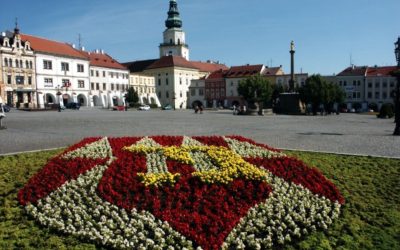The first written mention of Kroměříž appears around the year 1107. Originally it was a market village at a ford across the river Moravia. It was located at the crossroads of two important trade routes, the Amber and the Salt. The market village was bought by Bishop Jan II of Olomouc. from Přemyslid prince Ota Černý for 300 hryvnias of silver. In 1260, the village was promoted to a town. In the same year, Bishop Bruno of Schauenburg, the owner of the city, rebuilt the original Romanesque courtyard into a Gothic castle. Two years later, he founded the Church of St. Mořice with the chapter and rebuilt the parish church of the Virgin Mary. The city was surrounded by walls with three gates: Kovářská, Vodní and Mlýnská. Another owner of Kroměříž became Bishop Dětrich, who in 1290 established city rights, namely the right of market, mile, brewing and toll.
Many scholars of that time came from Kroměříž, such as Jan Milíč from Kroměříž, a priest, a preacher and the predecessor of Jan Hus; John of Wednesday, the royal chancellor, scholar and founder of many guilds, or Nicholas of Kroměříž, a notary of the royal office, who led the Prague writing workshop. During the Hussite period, the city suffered from long wars. In 1470 it was occupied by a Hungarian military garrison and stopped by the lords of Šternberk. In 1509, Bishop Stanislav Thurzo invited King Vladislav II to Kroměříž, who saw a beautiful garden there. It was originally just a vegetable and flower garden under the castle in the area to the river Moravia. From the 15th century, its mission and appearance changed, and in the 17th century it was rebuilt into a Baroque garden as a continuation of the chateau to the staircase by the river (Podzámecká zahrada).
During the Thirty Years’ War, the city was partially destroyed. In 1643 and 1645, the Swedes began blasting the city. The walls and the Blacksmith’s Gate were demolished. The Water Gate, Ztracená Street and the chateau succumbed to the fire. Of the original 4,000 inhabitants, only 900 remain, and of the 244 burgher houses, 69 have survived. Two years later, a plague epidemic swept the city, killing another 1,200 people. The restorer, Bishop Karel Lichtenstein of Kastelkorn, built a bishop’s mint in Kroměříž in 1665. The construction of the baroque Libosad – Flower Garden began. It lasted ten years. He also had the castle repaired in the early Baroque style. In 1680, the town was again plagued by a plague epidemic.
In 1725, a sculpture of the Holy Trinity was built on Zelený ryk (today’s Riegrovo náměstí). A Baroque fountain on Masaryk Square and the Church of St. John the Baptist. The castle, built and equipped by the Bishop of Liechtenstein, became the crown of the town, which gained a truly princely appearance during his reign. In 1752, the town was again engulfed in fire. The castle partly succumbed to him. Many foreign artists and builders took part in the reconstruction. In the following period until the middle of l9. century, the Podzámecká Garden was expanded, modified and decorated, so that it became one of the most valuable European landscape parks.
In 1805, Kroměříž was occupied by the Napoleonic army. Ten years later, the construction of the bridge over Moravia began. In 1848, due to the safety of the imperial family, the Constituent Assembly of the Revolutionary Movement was transferred from Vienna to Kroměříž. The city had to prepare for this event – it had new lighting, a telegraph line built, and the National Guard guarded the order in the streets. It was necessary to provide accommodation for important deputies such as F. Palacký, K. H. Borovský, J. K. Tyl, F. L. Rieger. Memorials to these personalities are still memorial plaques on the houses where they were accommodated. The Assembly was opened on November 22, 1848 and it was a new constitution. However, the assembly was closed after the night occupation of the city from March 6 to 7.
At the end of II. World War II Soviet and Romanian armies began to liberate cities from fascists. The first liberated village in the vicinity of Kroměříž became the village of Jestřabice, on April 29, 1945. On May 1, Střílky, Morkovice, Pornice and Slížany followed. On May 4, the liberation of Kroměříž began. In the evening, the city on the right bank of the river was liberated. At eight o’clock in the evening, the Germans set fire to a grenade from
ámeckou věž, avšak oheň se podařilo téměř okamžitě uhasit, takže nevznikly žádné velké škody. První sovětští vojáci přijeli do Kroměříže 7. května 1945.
V roce 1997 byla Kroměříž vyhlášena nejkrásnějším historickým městem. V červnu téhož roku byla část města zasažena „Stoletou vodou“. V roce 1995 byly kroměřížské zahrady a zámek zařazeny mezi Národní kulturní památky České republiky a v prosinci 1998 zapsány na listinu světového kulturního dědictví UNESCO.
Kroměříž bývá nazývána „Hanáckými Athénami“, neboť je centrem kultury, umění, historických památek. Město je dějištěm každoročních hudebních festivalů, výstav, odborných konferencí, sympozií a kongresů.

